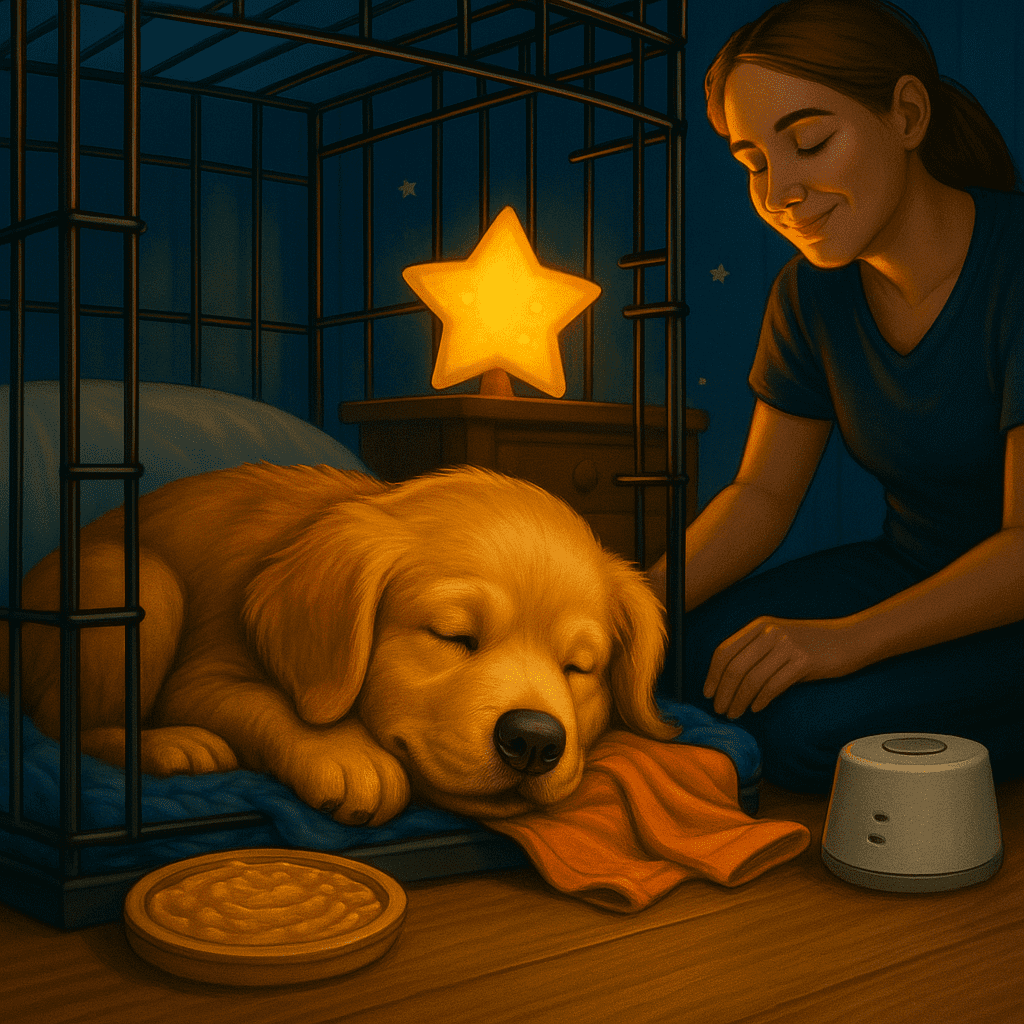How to Help Your Puppy Settle at Night: Calm Nighttime Protocol

Why Puppies Don’t Settle at Night
If you’re wondering how to help your puppy settle at night, you’re not alone. Nighttime chaos is common in puppies, especially during their first weeks home. But it isn’t defiance—it’s unmet needs. Puppies struggle to sleep due to:
- 🌙 Lack of a predictable bedtime routine
- 🧠 Overstimulation before sleep
- 🐾 Separation distress
- 🍽️ Late feeding or poor timing of water
- 🧊 Unmet physical or mental needs
🛏️ How to Help Your Puppy Settle at Night (Step-by-Step)
This is happening: Your puppy whines, paces, or claws at night—unable to settle or sleep.
So do this: Use this 3-phase nighttime routine to reduce restlessness and create dependable sleep habits.
🛰️ Step 1: Pre-Bed Checklist (30–90 Minutes Before Crate Time)
- 🐕 Potty break — no exceptions, even if they just went
- 🏃♂️ Low-arousal play or walk to drain energy (avoid roughhousing)
- 🧠 Puzzle feeder, sniff mat, or slow licker (15–30 min before crate)
- 💧 Pick up water 1 hour before bedtime
- 🌡️ Ensure room temperature is cool and crate area is quiet
🧘 Step 2: Calm Crate Entry
- 🎶 Use calming sound machine or fan
- 🧴 Use a calming pheromone spray (Adaptil or similar)
- 🛏️ Place a soft blanket with your scent in the crate
- 🦴 Offer a frozen Kong or lick mat as you cue: “Time for bed.” (same voice tone each time)
🚫 What NOT to Do
- ❌ Don’t engage if they whine—wait until silent, then reinforce calm
- ❌ Don’t put them to bed wired or underexercised
- ❌ Don’t skip the pre-bed mental enrichment
- ❌ Don’t move them to your bed out of pity—it builds long-term dependency
🕐 Step 3: Consistency + Decompression
- 🛡️ Follow the same routine daily to help your puppy settle at night, even on weekends
- 🔁 If they bark/whine, pause, reset (brief potty if needed), then return to crate
- 📈 Chart their night progress—celebrate calm nights with a sticker chart or digital tracker
🧰 Tools That Help Your Puppy Settle at Night
- 🎧 White noise machine or playlist
- 🧊 Lick mat, snuffle mat, frozen Kong
- 🛏️ Covered crate or crate canopy
- 🧼 Soft-scented blanket with your scent
- 📱 Baby monitor (audio-only) for reassurance without checking
Max’s Midnight Meltdowns

How One Puppy Learned to Sleep Without Fear
Max was a golden retriever puppy—8 weeks old, soft as a teddy bear, and full of nervous energy. He had been rescued from a noisy breeder’s lot where nights were filled with barking, chaos, and cold floors. Now in a quiet home with a loving guardian, everything should have felt safe. But it didn’t.
.
Every night, like clockwork, Max would start crying the moment the lights dimmed.
.
The crate became a symbol of loneliness. He’d bark, whine, scratch at the door. His guardian, exhausted and heartbroken, tried everything: letting him cry it out, moving the crate room to room, even sleeping on the floor beside him. Nothing worked. Every night ended in tears—for both of them.
.
“I felt like I was failing him,” she said. “I didn’t want to ignore him, but I didn’t know how to help him feel safe.”
The Turning Point
Max’s guardian began a calm nighttime routine after reading about emotional desensitization and classical conditioning. She shifted from survival mode to structure and trust-building.
.
Each night now began with the same rhythm:
- A white noise machine playing soft rain.
- A peanut butter-stuffed lick mat placed inside his crate.
- A warm blanket that smelled like her shirt.
- A calm phrase repeated like a lullaby: “Time to rest. You’re safe.”
She never forced him into the crate. She let him explore it with curiosity, and rewarded him each time he went in willingly—even if only for a moment.
A Quiet Breakthrough
On night six, something changed. Max walked into the crate himself. He curled into the blanket, softly licking his mat. No whining. No panic. Just a slow exhale.
For the first time, his guardian didn’t cry from frustration—but from relief.
.
“I couldn’t believe it. He looked at me once, yawned, and closed his eyes. He trusted me.”
Max didn’t just learn to sleep—he learned he wasn’t alone anymore. With structure, patience, and empathy, chaos gave way to calm.
.
💤 Frequently Asked Questions: How to Help Your Puppy Settle at Night
Q: Why does my puppy struggle to fall asleep at night?
A: Puppies often feel anxious when adjusting to a new environment. They may miss their littermates or feel unsure about the noises and routines of your home. Creating a calm, predictable bedtime routine is key to helping your puppy settle at night.
Q: Should I leave a light on or play music while they sleep?
A: Some puppies find white noise or soft ambient music soothing. If your puppy startles easily, a quiet background sound may help mask disruptive noises and help your puppy settle at night more peacefully.
Q: How long will it take for my puppy to sleep through the night?
A: Every puppy is different, but most will start sleeping through the night consistently between 12–16 weeks of age. Consistency, comfort, and positive reinforcement can help your puppy settle at night faster and with less stress.
.
📦 Crate Training Blueprint: Raise a Calm, Confident Puppy
Struggling with barking, reactivity, or nighttime chaos? The root cause often starts in the home environment. This $7 PDF kit gives you the science-based, emotionally attuned strategy to build calm—one crate session at a time.
👉 Download the Crate Training BlueprintFinal Thoughts
A restless pup at night isn’t broken—it’s just unstructured. Calm is a pattern, not a personality. With consistency, enrichment, and a solid routine, your dog will learn to settle and feel secure.
🧠 “Confused dogs can’t rest. Confident dogs sleep deeply.”
🧠 Training Methods in Action
